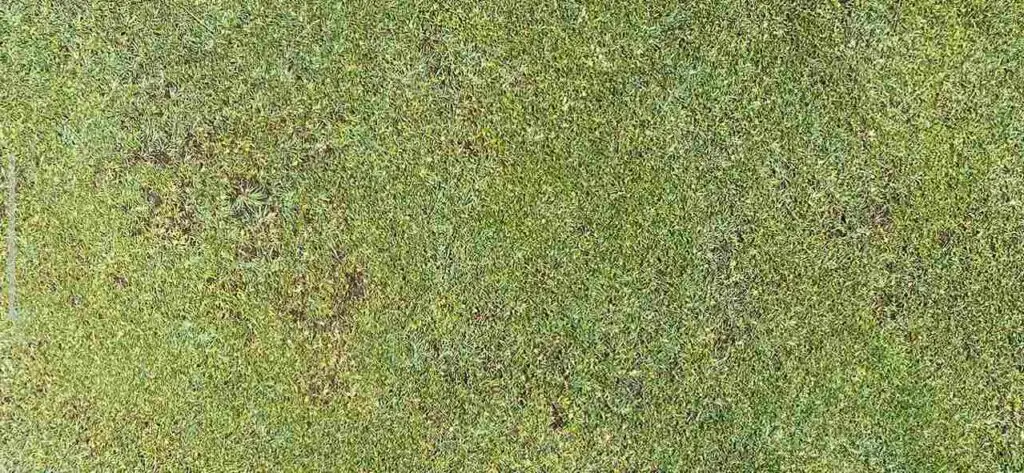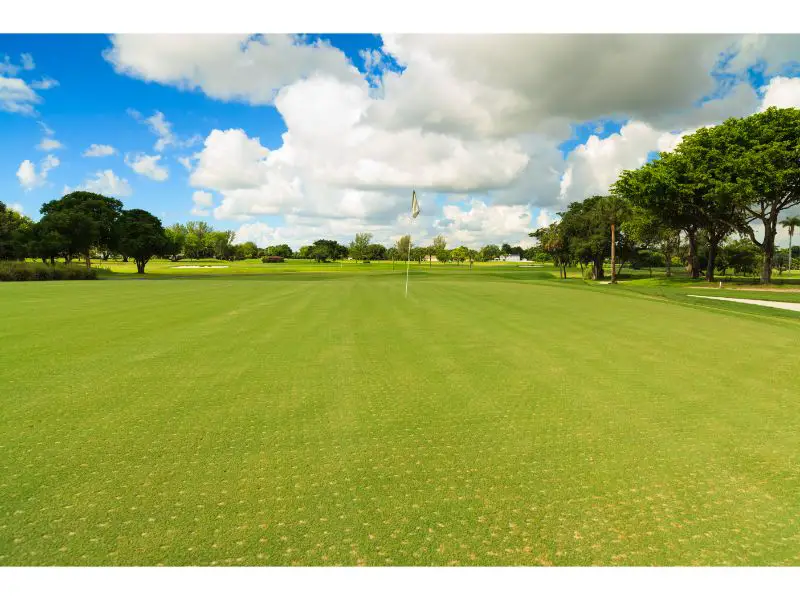Every golfer dreads the day when they show up to the golf course to see holes punched into the greens and sand spread liberally about them. Some golfers, just turn right around and head home.
The more faithful golfers begrudgingly stick around to play their rounds.
If aerating greens is a universally despised process, why do golf courses do it, and how long does it take for them to recover?
It typically takes two weeks for aerated greens to recover. This timetable is heavily dependent on weather and post-aeration green care.
Aerated greens need water along with warm days and cool nights for a fast recovery.
Manually watering the greens can ensure they get adequate moisture, even if the weather isn’t cooperating. Temperature and sunlight aren’t as controllable.
Typically, greenskeepers will plan to aerate around the weather to promote a speedy recovery.
5 Factors Affecting Aerated Green Recovery Time
1. Type Of Aeration Method Used
The choice of aeration method plays a significant role in determining the recovery time for aerated greens.
Different techniques, such as core aeration and solid-tine aeration, have varying impacts on the turf and soil.
Core aeration, which involves the removal of small soil cores, creates larger holes and promotes better water and air circulation.
On the other hand, solid-tine aeration uses solid tines to create smaller holes, causing less disruption to the playing surface.
2. Timing Of Aeration During The Year
The timing of aeration is crucial in determining the recovery time of aerated greens.
Green aeration is performed during periods when the turfgrass actively growing and can quickly recover.
For cool-season grasses, spring and fall are ideal times, as these seasons provide optimal growing conditions.
In contrast, warm-season grasses recover more rapidly when aerated during their peak growing season, typically in late spring or early summer.
Aeration during extreme weather conditions, such as excessive heat or drought, may prolong recovery time.
3. Climate And Weather Conditions
The climate and weather conditions have a significant influence on the recovery time for aerated greens.
Regions with milder climates and adequate rainfall tend to have faster recovery rates compared to areas with harsher climates or limited precipitation.
Factors such as temperature, humidity, and sunlight exposure also affect the growth and health of the turfgrass.
Warmer temperatures and favorable moisture levels promote quicker recovery, while extreme heat or prolonged periods of rain can impede the process.
4. Maintenance Practices Following Aeration
Proper post-aeration maintenance practices greatly contribute to the recovery time of aerated greens.
Immediately after aeration, the greens should be top-dressed with a compatible material, such as sand or a sand-soil mix, to fill the holes and create a level playing surface.
Regular watering is essential to keep the turf hydrated and facilitate root growth. Additionally, a balanced fertilization program tailored to the specific needs of the grass type promotes healthy regrowth.
It is crucial to follow recommended maintenance practices to optimize recovery time.
5. Health And Condition Of The Turfgrass Before Aeration
The health and condition of the turfgrass before aeration also impact the recovery time.
Greens that are already in good health and have a dense turf cover tend to recover more rapidly.
Well-maintained turf with a strong root system and adequate nutrient levels can bounce back quicker after aeration.
On the other hand, greens with existing issues, such as disease or poor soil quality, may require additional time and specialized treatments to recover fully.
Why Golf Courses Aerate Their Greens?
Greens are aerated to help combat soil compaction and remove thatch. Golf greens get heavy traffic on the course throughout the year and, as a result, the soil under the green gets compacted over time.
Aeration helps to reverse this process and allows space for new grassroots to grow.
Aeration also helps prevent thatch build up. Thatch is old plant material that gathers under the green surface over time. Aeration helps to remove this thatch layer of soil for health greens.

When Do Golf Courses Aerate Their Greens?
Golf greens are aerated when they are at their healthiest. Grass grows best on warm days and cool nights, so aerations typically take place in late spring and early fall, depending on location.
That said, a course can be aerated whenever the greenskeeper feels like it’s necessary. In some cases, individual greens may be aerated multiple times a year if is prone to disease due to location, climate, or poor initial design.
Do You Post Your Scores When Playing On Aerated Greens?
Generally speaking, you should not post scores for a handicap if you are playing on aerated greens. Your score will be dramatically impacted by putting on aerated greens so posting that score would not be indicative of your true ability.
It is best to post scores on days when the course will reflect your real scoring ability.
One exception would be if you need a score for your handicap for an upcoming event. Be sure, to be honest with your estimated score, nobody likes a sandbag!
Do You Pay Full Price When Greens Are Aerated?
As with many golf course-specific answers, it depends on the golf course. Typically, there is no discount if you play on aerated greens. To make matters worse, some courses will not tell you if the greens have recently been aerated.
If the idea of playing on aerated greens is too much of an annoyance and not worth the greens fee, then we suggest calling before booking a tee time when it’s aerating season in your area.
This is the best way to avoid a disappointing trip to the course.
How Does Playing On Aerated Greens Affect Your Score?
Aerated greens can impact your ability to play well. Not surprisingly, the more recently the greens were treated, the harder it is to putt.
Trying to put on the aerated green can turn a normal two-putt into 3+ depending on the condition. Playing on aerated greens can easily add 10+ strokes.
For this reason, most golfers will follow a two-putt rule for newly aerated greens. This is a good rule of thumb for the next time you are out playing on aerated greens.
Do Golf Courses Really Need to Aerate Greens Twice a Year?
If we are being honest, playing golf on aerated greens is an awful experience. Especially, given that greens get aerated when they are at their best. So, this begs the question of does it even matter if greens get aerated?
As inconvenient as it is, aerating greens twice a year really is necessary. Playing a couple weeks of golf with punched greens is well worth it if you have healthy greens for the rest of the year.
Greenskeepers probably can get away with aerating once a year but it’s not worth it. Its best to take care of the course and just deal with the annoyance.
If aerated properly with appropriate post aeration care, the green should be back to normal in two weeks.
Final Thoughts
Let’s recap the above. Nobody likes to play golf on aerated greens. Luckily for us, we now know that it usually only takes a couple of weeks for the greens to get back in form.
If you have the golf itch and need to get out when the greens are aerated, it’s important to remember that you usually will not get a discount.
Use the two-putt rule to keep the pace of play going and we would recommend not posting any scores while greens are at their worst. Hopefully, you found this information on green aerations helpful!
Interested in learning more about golf course maintenance? Check out our article on why Golf Courses Are Always Cutting Down Trees and our other blog posts!



1 thought on “How Long Does It Take Aerated Greens To Recover?”